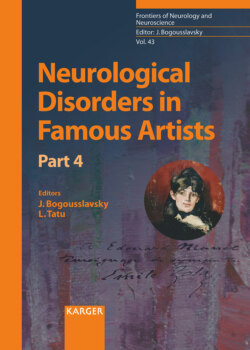Neurological Disorders in Famous Artists - Part 4

Реклама. ООО «ЛитРес», ИНН: 7719571260.
Оглавление
Группа авторов. Neurological Disorders in Famous Artists - Part 4
Frontiers of Neurology and Neuroscience
Neurological Disorders in Famous Artists – Part 4
Contents
Preface
Joan Miró and Cyclic Depression
Abstract
Art and Psychopathology
Joan Miró’s Biography Summarized
Joan Miró and Cyclic Depression
Conclusions
Acknowledgements
References
Abstract Expressionists and Brain Disease
Abstract
The Irascible Eighteen
James Brooks
Willem de Kooning
Agnes Martin
References
Louis-Ferdinand Céline: From First World War Neurological Wound to Mythomania
Abstract
The Neurologic War Wound
The Radial Nerve Surgery
The Mythology of Trepanation
A Train in the Left Ear
Céline: A Shell-Shocked Soldier?
Acknowledgments
References
Creative Minds in the Aftermath of the Great War: Four Neurologically Wounded Artists
Abstract
Jean-Julien Lemordant: The “Painter with Closed Eyelids”
Maurice Prost: The Resilient Body
Georges Braque: The Trepanned Painter
Fernand Léger: Cubism at War
Acknowledgments
References
Writers as Shell Shock Witnesses during World War I
Abstract
War Commotion
War Emotion
Psychiatric Forms of Shell Shock
War Hysteria
Electrotherapy
Pathological Fear
Acknowledgments
References
Édouard Manet’s Tabes Dorsalis: From Painful Ataxia to Phantom Limb
Abstract
The Father of Impressionism
Manet’s Disease
Tabes Dorsalis in Manet’s Time
References
Thomas Mann and Neurology
Abstract
Biographical Sketch
Interest in Diseases
Neurological Disorders in Thomas Mann’s Novels. Epilepsy
Meningitis
Essential Tremor
Neurosyphilis
Migraines
Conclusion
References
Arthur Rimbaud: “The Man with Wind Soles” – Riders’ Osteosarcoma with Postamputation Stump Pain
Abstract
Rimbaud’s Disease
Stump Pain versus Phantom Limb: Insight from Rimbaud’s Correspondence
References
Travelling into Alienation and Neurology with a Painter: Georges Moreau (1848–1901)
Abstract
A Family Saga Played Out in Insane Asylums
Trained as an Academic Painter
A Short Life
Academic Work (1875–1893)
Expression of Emotions
Les Morphinées
A Stigmatic in the Middle Ages and an Ecstatic in the Eighteenth Century
A Vision, a Hallucination
Cicada or Mandolin
Heinrich Heine
Les Fascinés de la Charité, Service du Dr Luys
Une Leçon Clinique à La Salpêtrière by André Brouillet
Physicians
Moreau’s Style after His Stroke
Acknowledgements
References
Neurology in Russian Writers: Tolstoy and Turgenev
Abstract
Leo Nikolaevich Tolstoy
Ivan Sergeyevich Turgenev
Russian Culture Abroad in the Nineteenth Century
Russian Neurology, Psychiatry, and Psychology in the Nineteenth Century
Tolstoy and His Depression: How it Changed His Literary Philosophy
Turgenev: A Spinal Cord Tumor Stopped His Literary Career
Differences between Tolstoy and Turgenev
Conclusions
References
Raymond Roussel’s Cure with Pierre Janet
Abstract
Who Was Raymond Roussel?
Childhood of a Paedophile (a term we use in its literal sense of a love for children)
The Raymond Roussel Case
Raymond Roussel: The Man
“Poor Little Sick Boy”
The Crisis of 1896
Continuing Observation
Pierre Janet’s Psychotherapy
Contemporary Comments on the Janet/Roussel Relationship
Evolution. Other Care
Death in Palermo
The Work of Raymond Roussel
Roussel’s Work: His Reception
Sense of the Surrealists’ Support for Roussel and Their Hostility towards Janet
Is Raymond Roussel’s Work that of a “Literary Madman”?
Conclusion
Acknowledgements
References
Henrik Ibsen’s Battle with Cerebrovascular Disease
Abstract
Dr. Edvard Bull’s Notes
Ill with Influenza?
An “Apoplectic Incident”
Trouble with Finding Words
Heart Trouble
Arteriosclerosis
References
Letter to His Father by Franz Kafka: Literary Reconstruction of a Traumatic Childhood?
Abstract
Who Was Franz Kafka?
Why Speak about Franz Kafka? His Role in Current Literature and Literary Thought
Did Kafka, in Fact, Experience a Traumatic Childhood?
A Father-Son Relationship Analogous to the Social Defeat Model?
Letter to His Father and the Universal Subjectivity of Autobiographical Memory
Letter to His Father and the Inherent Instability and Malleability of Memory
Letter to His Father and How Literature Resembles and Arises from Autobiographical Memory
Final Considerations: Does Letter to His Father Explain Kafka’s Literature or Is it Part of the Literary Universe He Created?
References
Dementia and Change of Style: Willem de Kooning – Obliteration of Disease Patterns?
Abstract
Life and Art
Dementia and Painting
References
Machado de Assis’ Original Sin
Abstract
Biographic Note
Medical History
Literary Work
Conclusions
References
Cesare Pavese: The Laboratory of Loneliness – A study of Among Women Only
Abstract
Emotional Refraction
A Blue Ball Gown
Only a Matter of Time
“Like an Acrobat or Candy Seller”
“I Will Write Nothing More”
“No-One Ever Kills Himself for Love of a Woman”
Reversed Polarities
The Burden of Loss
Two Cats
References
Dissociation, Delusion and the Splitting of the Self in The Trial by Franz Kafka: Phenomenology and Neurobiology of Schizophrenia
Abstract
The Trial: Summary and Literary Features
Dissociative Experiences in The Trial: Space Perception, Spatial Orientation and Sense of Reality
Delusional Experience in The Trial: The Phenomenology of Prodromal Schizophrenia
Relating the Phenomenology to a Neurobiological Model of Delusion: Chaotic Dopaminergic Firing and False Salience Attribution
Self-Disorders and Thought Disorders in The Trial: Ambivalence and the “Doppelgänger” Motif in Kafka’s Writings and Life
Reader’s Response to The Trial: The Difficulty of Empathizing with Josef K. and How the Novel Brings the Reader to a Delusional Mood
Conclusion
References
Author Index
Subject Index
Отрывок из книги
Vol. 43
Series Editor
.....
Walusinski, O. (Brou)
Neurology in Russian Writers: Tolstoy and Turgenev
.....